Is it safe to perform manicures and pedicures on clients undergoing treatment for cancer?
MARC INNES, HEAD OF TRAINING AND EDUCATION, CANCER TOUCH THERAPY: With new developments and initiatives in the industry, many spas and salons are undergoing specialist training, in order to open their doors to clients undergoing treatment for and recovering from cancer.
The outdated idea that massage can spread cancer has been turned on its head, with new research and understanding about the real concerns in treating clients, who, for example, may be undergoing chemotherapy and wanting a spa or salon treatment to give themselves a well-deserved treat.
As Head of Training for the Made for Life Foundation, my colleagues and I spent a considerable amount of time, using our own pre-existing knowledge and research, backed up by our contacts in the oncology world.
One of the issues we considered was whether it was safe to carry out manicures and pedicures, as this, traditionally has always been the perceived ‘safe option’, as opposed to massage. Accordingly, we set to work on risk assessing the safety of these treatments.
Nail conditions
Chemotherapy can cause a variety of nail conditions, which are of concern for manicure/pedicure treatments. Nails can become brittle, weak, or porous during chemotherapy – they may also separate from the nail bed (Onycholysis), allowing infection to develop potentially if the right care isn’t taken.
Fingernails are affected more than toenails, but both can suffer. Nails usually grow normally again around six months after finishing treatment, but in some cases, we have seen on-going issues in some clients – toenail issues may persist for a year or even longer.
Immunity
What is clear for those undergoing chemotherapy, is that the immune system can often be compromised – thus leaving some patients at increased risk of infection. Chemotherapy can cause Neutropenia, a condition which leaves the patient with low white blood cells (Neutrophils in this case) which, as we know, fight off bacterial and fungal infections.
Lymphoedema
We also know that many women for example, are at risk of hand/arm Lymphoedema (a condition where lymph cannot drain properly, due to removal of or radiotherapy to lymph nodes) after axillary node removal with breast cancer treatment.
In other cases, a gynaecological related cancer can result in the removal of inguinal nodes in the groin – potentially, this could cause Lymphoedema in the lower body, legs and feet.
We know that not all patients develop Lymphoedema, but those who have had nodal removal must practice risk reduction. Treatments in our industry that could be hazardous to nodal removal include heated treatments, waxing and massage to name a few. We also know that one of the biggest risk factors in the development of Lymphoedema is infection!
Weighing up the risks
In consideration of the above, it can be understood that approaches to manicures and pedicures, without sufficient knowledge and care, can be hazardous. We would strongly suggest that anyone undertaking these types of treatments seek out the correct training, in order to be equipped with all the facts surrounding chemotherapy and other cancer related treatments. See the Made for Life Foundation website for more details. madeforlife.org

